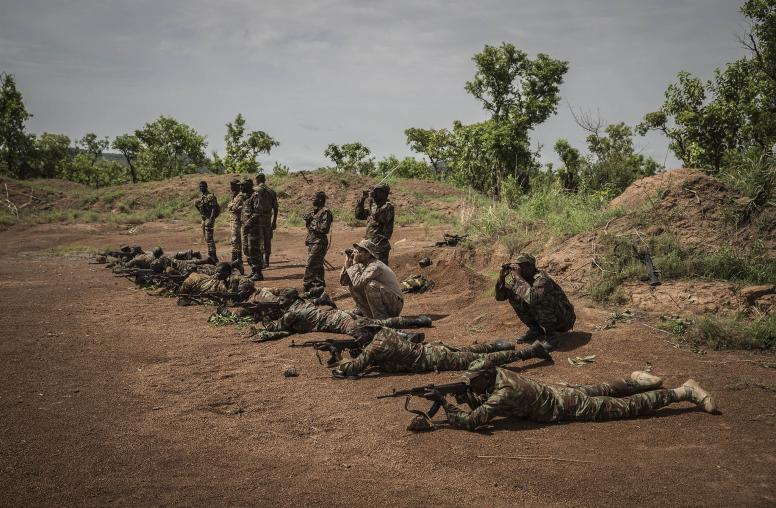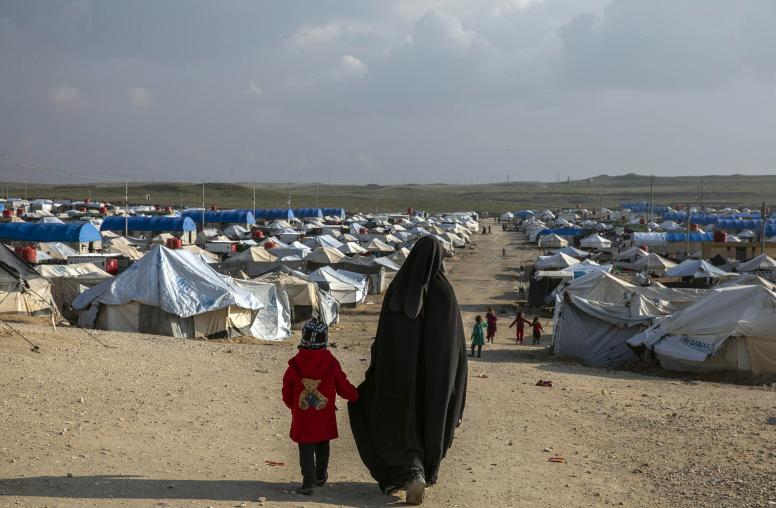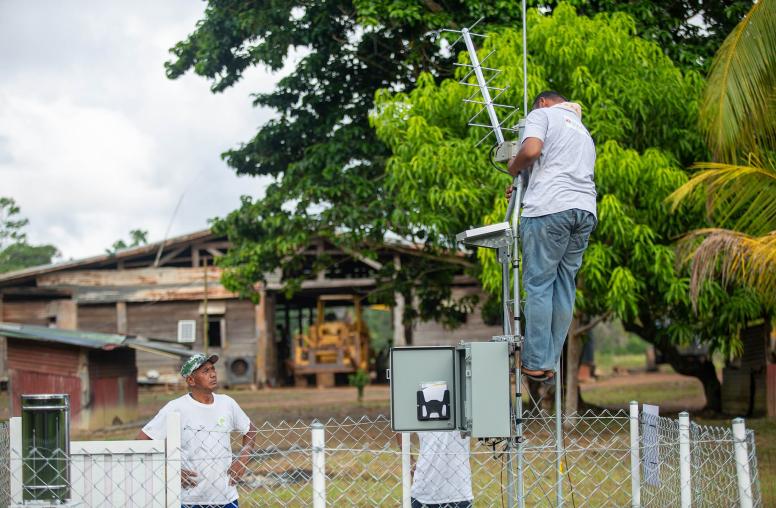Guns, Camps and Deradicalization: Violent Extremists in Conflict Zones
What are the differences between disengagement and rehabilitation programs in stable settings and in conflict zones?
Violent extremists make civil conflicts more complex and less manageable. Whether in the Middle East, Africa or South Asia, one of the many problems presented by conflicts involving violent extremists is how to deal with these combatants and associates when they surrender or are captured. There have been many attempts to disengage, deradicalize, rehabilitate and reintegrate violent extremists around the world, but most research focuses on stable settings such as Western Europe and North America. What, then, do we know about how to do this in the middle of conflict?

It’s one thing to put a terrorist offender in a Western prison through a disengagement and rehabilitation program. But the challenges are far greater in a location such as northeast Syria. The territorial defeat of the Islamic State group (ISIS) left around 10,000 former combatants and thousands of family members in the hands of the Syrian Democratic Forces (SDF) and its political wing, the Syrian Democratic Council (SDC).
But what is the status of the former combatants? Are they criminals or prisoners of war? Are their families displaced victims, or should they be viewed as suspected perpetrators? How should they be treated, and by whom? The SDF and SDC may have de facto jurisdiction, but they are not recognized as sovereign by any country and are under military and political pressure on all sides. And as several political controversies in recent years have shown, few states seem interested in taking responsibility for even the most vulnerable and most victimized of their own citizens in northeast Syria.
Is ‘Deradicalization’ the Solution?
Deradicalization, albeit under different labels, is certainly in vogue. Many countries now put violent extremists through programs designed to reduce the risk they pose and, ultimately, to reintegrate them into society. Proponents of deradicalization argue that former jihadists and their affiliates should where possible be put through a program which cleanses them of their violent extremist beliefs, earning them the right to return to their communities and reducing the security risk they present to their communities and beyond.
Indeed, U.N. Security Council Resolutions 2178 (2014) and 2396 (2017) require member states to implement “prosecution, rehabilitation and reintegration strategies” for a particular category of violent extremists: the foreign terrorist fighters (FTFs) returning to their home countries from the conflict in Syria. These resolutions responded to the threat that FTFs posed to the 100 or so countries from which they came — but did not appear to foresee that the majority of surviving ISIS fighters and followers, whether FTFs or Syrians or Iraqis, would remain for years within the borders of Syria and Iraq. The Security Council has yet to conclude what is to be done about them.
These resolutions carefully avoid the term “deradicalization,” and with good reason. The academic study of what psychologists prefer to call “disengagement” of terrorists and violent extremists has developed significantly in the last decade. One key insight is that there is a difference between changing someone’s behavior and changing their mind, and the former is probably more achievable. For academic psychologists, the term deradicalization conjures up associations with discredited approaches to ideological deprogramming, and fails to acknowledge the observed reality that people leave terrorist groups and violent extremist movements for all sorts of reasons; many of those who leave voluntarily retain many of their radical views. Deradicalization also potentially stigmatizes individuals who might have joined a violent group for reasons other than ideology — because they have been conscripted or needed the group’s protection or money.
Still, the term deradicalization is widely used by practitioners and policymakers dealing with violent extremists in conflict-affected countries. This may in part be due to differences in setting and context. In settings such as North America and Western Europe, domestic violent extremism is at heart a criminal justice problem to be dealt with through laws and law enforcement; techniques promoting desistance from crime and subsequent rehabilitation are standard elements of an advanced approach to criminal justice. It is not necessary to change a criminal’s worldview — we just want them to stop committing crimes, and then to become a better citizen.
Differences in Conflict Zones and Stable Environments
But in places where extremists are not so much anti-social elements as parties in a civil conflict, questions of ideological allegiance can be critical. If the aim is to reintegrate former extremists in their communities, then the communities themselves must be ready to accept them.
This applies not just to how former combatants and supporters behave, but to how they are perceived. In stable settings, violent extremists can be offered incentives to disengage, including the prospect of living a more socially productive life. In Iraq, where ISIS members generally receive the severest penalties — including execution — disengagement appears to have a low priority and incentives are likely to be limited.
This is just one way in which disengagement and reintegration of violent extremists differs between stable and unstable settings. Some of the differences are obvious — but they still have significant implications for what programs can achieve and how. Basic security, for instance, is a given in Western settings for disengagement, but in northern Syria, disengagement activities may take place in ramshackle buildings repurposed as detention facilities. Or in the places like the al-Hol camp where, according to outgoing former Special Envoy to the Global Coalition to Defeat ISIS James Jeffrey, ISIS-affiliated women engage in “violence, intimidation and indoctrination” of the camp’s population, and over 30 murders have reportedly taken place in just two months in 2021.
Institutional capacity is another significant difference. Disengagement and reintegration programs in countries like the United Kingdom may be dealing with numbers in the low hundreds and with access to that country’s well-resourced counterterrorism apparatus — and still success is far from guaranteed. By contrast, the de facto authorities in northeast Syria currently have responsibility for thousands of former ISIS combatants in addition to thousands more ISIS-linked families in camps for refugees and internally displaced people (IDPs) such as al-Hol. These authorities operate within extraordinary financial, logistical and political constraints that limit their access to expertise as well as resources.
It is little wonder that the SDC and the U.S. government both judge that the problem far outweighs the resources available for disengagement and rehabilitation. Screening, vetting and evaluating individuals throughout the disengagement process is essential, and much research has gone into evaluating the approaches and tools to support these tasks. But they require money, time and expertise, all of which are in short supply. Against this background, the SDC’s decision to release hundreds of low-level operatives and to offer a “general amnesty” to Syrian families in IDP camps has been judged by the State Department to be a pragmatic one.
Implications
What, then, are the implications of these differences for our understanding of violent extremist disengagement and reintegration?
- External context really matters and needs greater attention. The advances made by academic psychologists and criminologists have focused on the cognitive and behavioral mechanisms that facilitate or obstruct disengagement. But we need also a better understanding of the factors external to the individual, which will affect what programming can actually achieve in fragile environments, and thereby help overcome external constraints — or even shape political environments to make disengagement more achievable.
- Researchers and practitioners need to focus more on reintegration. No one can be successfully reintegrated into a community that simply does not want to receive former extremists, and barriers to reintegration in the community, such as fear, distrust or a perception that criminals are being rewarded and not punished — as have affected Nigeria’s attempts at large-scale reintegration — need to be understood and managed.
- Given the numbers of violent extremists in locations like Syria, Iraq and Nigeria, we need to learn from large-scale demobilization, disarmament and reintegration (DDR) efforts. These have been attempted, with varying degrees of success, in conflicts where violent extremists have not been involved. So-called “first-generation” DDR programs, which focused on “guns, camps and cash” — disarming, cantoning and providing financial support to former combatants — have been criticized on several grounds. But we can learn from failures as well as successes. In any case, DDR is now judged by some to have entered a new phase in which interventions are adapting to ongoing conflict, dealing with ideologically motivated participants, and aligning with stabilization, peacebuilding and development activities. The DDR and counterterrorism communities have a lot to teach each other.
The particular challenges to peace and security posed by violent extremists in the global South need responses tailored to local contexts. The cost of not investing in disengagement programs is simply too high. The question is how to do it at scale, in unforgiving environments, and with limited resources. That is a challenge for the international community as much as it is for countries in and emerging from civil conflict.



